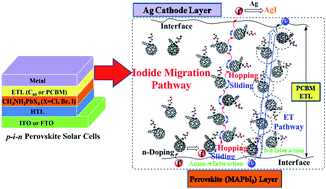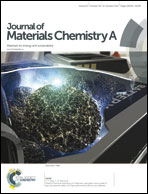Halide anion–fullerene π noncovalent interactions: n-doping and a halide anion migration mechanism in p–i–n perovskite solar cells†
Abstract
Iodide–fullerene π interactions play decisive roles in n-doping and electron transport of fullerenes at the perovskite–PCBM interface in the devices of perovskite solar cells (Pero-SCs). But instability issues of perovskites due to halide anion migration greatly limit the practical application of Pero-SCs. To fully understand the properties of these interactions, we conducted systematic studies on fullerene ammonium halides containing I−, Br−, and Cl− that exist in perovskites. Our findings show that fullerene is an overwhelmingly strong electron acceptor that activates relatively inert halide anions (Br− and Cl−) and initiates the n-doping process by forming anion–π interactions, which are closely related to the performance and stability of the p–i–n Pero-SC devices based on a CH3NH3PbX3 (X = I, Br, and Cl) light absorber and a fullerene (C60 or PCBM) electron transport layer (ETL). At the perovskite–fullerene interface in the p–i–n Pero-SC, n-doping occurs by forming iodide–fullerene π interactions, which facilitates charge transport and improves the performance of the devices by suppressing hysteresis. On the basis of experimental evidence and computational results, we propose a plausible mechanism for iodide migration attributed to its n-doping at the interface and subsequent hopping of slidable iodide to a neighbouring fullerene given that space and energy are favorable. Thus, the migration of halide anions through the fullerene layer results in perovskite degradation and performance decay of the devices. This work highlights the importance of halide anion–fullerene π interactions in materials chemistry and explores the introduction of a halide anion blocking ETL in p–i–n Pero-SCs.



 Please wait while we load your content...
Please wait while we load your content...